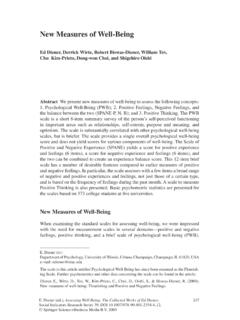Transcription of A-level Psychology Mark scheme Paper 2 June 2017
1 A- Level Psychology 7182/2 Psychology In Context (New) Final Mark scheme 7182 June 2017 Version/Stage: Mark schemes are prepared by the Lead Assessment Writer and considered, together with the relevant questions, by a panel of subject teachers. This mark scheme includes any amendments made at the standardisation events which all associates participate in and is the scheme which was used by them in this examination. The standardisation process ensures that the mark scheme covers the students responses to questions and that every associate understands and applies it in the same correct way. As preparation for standardisation each associate analyses a number of students scripts. Alternative answers not already covered by the mark scheme are discussed and legislated for. If, after the standardisation process, associates encounter unusual answers which have not been raised they are required to refer these to the Lead Assessment Writer.
2 It must be stressed that a mark scheme is a working document, in many cases further developed and expanded on the basis of students reactions to a particular Paper . Assumptions about future mark schemes on the basis of one year s document should be avoided; whilst the guiding principles of assessment remain constant, details will change, depending on the content of a particular examination Paper . Further copies of this mark scheme are available from Copyright 2017 AQA and its licensors. All rights reserved. AQA retains the copyright on all its publications. How ever, registered schools/colleges f or AQA are permitted to copy material f rom this booklet f or their ow n internal use, w ith the f ollow ing important exception: AQA cannot give permission to schools/colleges to photocopy any material that is acknow ledged to a third party even f or internal use w ithin the centre.
3 MARK scheme A-level Psychology 7182/2 JUNE 2017 3 of 24 Level of response marking instructions Level of response mark schemes are broken down into levels, each of which has a descriptor. The descriptor for the level shows the average performance for the level. There are marks in each level. Before you apply the mark scheme to a student s answer read through the answer and annotate it (as instructed) to show the qualities that are being looked for. You can then apply the mark scheme . Step 1 Determine a level Start at the lowest level of the mark scheme and use it as a ladder to see whether the answer meets the descriptor for that level. The descriptor for the level indicates the different qualities that might be seen in the student s answer for that level. If it meets the lowest level then go to the next one and decide if it meets this level, and so on, until you have a match between the level descriptor and the answer.
4 With practice and familiarity you will find that for better answers you will be able to quickly skip through the lower levels of the mark scheme . When assigning a level you should look at the overall quality of the answer and not look to pick holes in small and specific parts of the answer where the student has not performed quite as well as the rest. If the answer covers different aspects of different levels of the mark scheme you should use a best fit approach for defining the level and then use the variability of the response to help decide the mark within the level, ie if the response is predominantly level 3 with a small amount of level 4 material it would be placed in level 3 but be awarded a mark near the top of the level because of the level 4 content. Step 2 Determine a mark Once you have assigned a level you need to decide on the mark.
5 The descriptors on how to allocate marks can help with this. The exemplar materials used during standardisation will help. There will be an answer in the standardising materials which will correspond with each level of the mark scheme . This answer will have been awarded a mark by the Lead Examiner. You can compare the student s answer with the example to determine if it is the same standard, better or worse than the example. You can then use this to allocate a mark for the answer based on the Lead Examiner s mark on the example. You may well need to read back through the answer as you apply the mark scheme to clarify points and assure yourself that the level and the mark are appropriate. Indicative content in the mark scheme is provided as a guide for examiners. It is not intended to be exhaustive and you must credit other valid points.
6 Students do not have to cover all of the points mentioned in the indicative content to reach the highest level of the mark scheme . An answer which contains nothing of relevance to the question must be awarded no marks. MARK scheme A-level Psychology 7182/2 JUNE 2017 4 of 24 Section A Approaches in Psychology 0 1 Explain why John s genotype will not reveal whether he will suffer from Alzheimer s disease. [4 marks] Marks for this question: AO2 = 4 Level Marks Description 2 3 - 4 Explanation is clear and coherent, showing sound understanding of genotype and phenotype/environmental factor. The material is applied appropriately. There is effective use of terminology. 1 1 - 2 The explanation shows some understanding of genotype and phenotype/environmental factor. Application is not always appropriate.
7 The answer lacks clarity and coherence. Use of terminology is either absent or inappropriate. 0 No relevant content Possible content: the genetic test reveals the genotype not the phenotype John s genotype will only reveal his set of genes (not their interaction with the environment) a genetic test will only reveal if he is predisposed to suffering Alzheimer s disease but will not reveal whether he will develop/suffer from the disorder environmental factors may contribute to the disorder (it depends on an interaction between inherited factors and the environment). Credit other relevant material. Note: merely defining genotype and/or phenotype is not creditworthy. MARK scheme A-level Psychology 7182/2 JUNE 2017 5 of 24 0 2 Describe the structure of the personality according to the psychodynamic approach.
8 [4 marks] Marks for this question: AO1 = 4 Level Marks Description 2 3 - 4 Knowledge of the structure of personality according to the psychodynamic approach is clear and mostly accurate. There is effective use of terminology. 1 1 - 2 Knowledge of the structure of personality according to the psychodynamic approach is incomplete/partly accurate. For 1 mark there may be very limited knowledge of the structure of personality or all 3 components may be simply named. Use of terminology is either absent or inappropriate. 0 No relevant content Possible content: personality is made up of 3 parts; the id, ego and superego. This point is essential for 4 marks. elaboration regarding the components the id: Focuses on self (selfish), irrational and emotional, deals with feelings and needs, seeks pleasure/hedonistic (reference to pleasure principle), formed from birth-18mo, unconscious part of the mind the ego: Rational, balancing the id and superego, reference to reality principle , formed between 18mo-3yrs, conscious part of the mind the superego.
9 Reference to morality principle , acts as the conscience or moral guide, based on parental and societal values, formed between 3-6yrs, unconscious part of the mind elaboration regarding the dynamic nature of the three components experience/conflicts in childhood shape the development of the 3 parts affecting how a person behaves description of the levels of consciousness Credit structural descriptions of personality according to other psychodynamic theorists. MARK scheme A-level Psychology 7182/2 JUNE 2017 6 of 24 0 3 Outline and evaluate the humanistic approach. Refer to Tatiana s behaviour in your answer. [16 marks] Marks for this question: AO1 = 6, AO2 = 4 and AO 3 = 6 Level Marks Description 4 13 - 16 Knowledge of the humanistic approach is accurate and generally well detailed.
10 Application is effective. Evaluation of the humanistic approach is thorough and effective. Minor detail and/or expansion of the argument is sometimes lacking. The answer is clear, coherent and focused. Specialist terminology is used effectively. 3 9 - 12 Knowledge of the humanistic approach is evident but there are occasional inaccuracies/omissions. Application/evaluation of the humanistic approach is mostly effective. The answer is mostly clear and organised but occasionally lacks focus. Specialist terminology is used appropriately. 2 5 - 8 Limited knowledge of the humanistic approach is present. Focus is mainly on description. Any application is of limited effectiveness. Any evaluation is of limited effectiveness. The answer lacks clarity, accuracy and organisation in places. Specialist terminology is used inappropriately on occasions.














